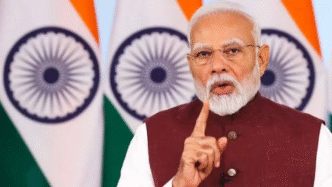On May 10, 2025, Pakistan intensified its provocations against India by deploying drones, including armed ones, across 26 locations along the International Border and Line of Control, from Jammu and Kashmir to Gujarat. This follows a massive assault involving 300–400 drones on May 7–8, which India’s armed forces successfully neutralized. The latest attacks have caused civilian injuries, triggered blackouts in multiple cities, and heightened security measures as India responds to Pakistan’s aggression, spurred by India’s Operation Sindoor targeting terror camps after the April 22 Pahalgam attack. Here’s a clear look at the situation, with answers to two key questions people are asking.
The Indian Army reported drone sightings in places like Baramulla, Srinagar, Avantipora, Nagrota, Jammu, Ferozepur, Pathankot, Fazilka, Lalgarh Jatta, Jaisalmer, Barmer, Bhuj, Kuarbet, and Lakhi Nala. In Ferozepur, Punjab, an armed drone struck a civilian area, severely injuring a local family with burn wounds. “We received information about three people being injured. They have burn injuries. Doctors will treat them,” said Bhupinder Singh Sidhu, Senior Superintendent of Police, Ferozepur. AAP MP Raghav Chadha condemned the attack, stating on X, “Pakistan has once again proven that it’s a terrorist state—firing drones into civilian areas of Punjab, Jammu & Kashmir, and Rajasthan. In my own state of Punjab, innocent civilians have been severely injured.”
To counter these threats, India’s air defense systems, including the S-400, are actively tracking and destroying drones. The Army emphasized, “The Indian Armed Forces are maintaining a high state of alert, and all such aerial threats are being tracked and engaged using counter-drone systems.” Residents, especially near borders, are urged to stay indoors, limit movement, and follow local safety instructions. Blackouts have been enforced in Akhnoor and Udhampur (Jammu and Kashmir), Ambala and Panchkula (Haryana), Firozepur (Punjab), and Jaisalmer (Rajasthan) to reduce visibility during potential attacks. In Srinagar, mosque loudspeakers instructed locals to switch off lights, while Jammu faced darkness amid sirens and blasts, as noted by Chief Minister Omar Abdullah on X: “Blackout in Jammu now. Sirens can be heard across the city.”
Prime Minister Narendra Modi held urgent meetings with Foreign Minister S. Jaishankar, National Security Advisor Ajit Doval, Defence Minister Rajnath Singh, and military chiefs to strategize. The government suspects Pakistan’s drones, possibly Turkish Asisguard Songar models, aimed to test India’s air defenses and gather intelligence. This escalation follows India’s Operation Sindoor, a response to the Pahalgam terror attack that killed 26 people, which exposed Pakistan’s terror links. Pakistan’s actions, including heavy artillery fire along the Line of Control, have led to civilian casualties, with three deaths reported in Rajouri, Jammu and Kashmir, on May 9.
Below are answers to two frequently asked questions about the ongoing crisis.
FAQ 1: Which areas in India are affected by Pakistan’s drone attacks and blackouts, and what’s being done to protect people?
Pakistan’s drones were spotted at 26 locations across India on May 9, 2025, including Baramulla, Srinagar, Avantipora, Nagrota, Jammu, Ferozepur, Pathankot, Fazilka, Lalgarh Jatta, Jaisalmer, Barmer, Bhuj, Kuarbet, and Lakhi Nala, spanning Jammu and Kashmir, Punjab, Rajasthan, and Gujarat. These attacks targeted both military and civilian areas, with a notable incident in Ferozepur, Punjab, where a drone injured a family. Blackouts have been enforced in Akhnoor, Udhampur, Ambala, Panchkula, Firozepur, and Jaisalmer to minimize risks during nighttime attacks, accompanied by air raid sirens in places like Jammu and Srinagar.
India’s armed forces are using advanced counter-drone systems and the S-400 air defense to neutralize threats, successfully intercepting most of the 300–400 drones sent on May 7–8 and many on May 9. The Army is on high alert, tracking drones and urging border residents to stay indoors and follow local authorities. In Srinagar, mosques used loudspeakers to guide people to turn off lights. Chief Minister Omar Abdullah appealed to Jammu residents to stay home and avoid spreading rumors, emphasizing community resilience. Forensic analysis of drone wreckage is underway to confirm their origins, with initial reports pointing to Turkish models.
FAQ 2: Why is Pakistan launching these drone attacks, and how is India responding?
Pakistan’s drone attacks are a retaliation to India’s Operation Sindoor, launched on May 7, 2025, which destroyed nine terror camps in Pakistan and Pakistan-occupied Kashmir after the April 22 Pahalgam attack that killed 26 people. Pakistan’s military, aiming to test India’s air defenses and possibly gather intelligence, launched 300–400 drones on May 7–8 and continued with attacks on 26 locations on May 9, including a Fatah-II missile aimed at Delhi, which was intercepted. The government believes these actions are meant to provoke and escalate tensions.
India’s response has been swift and robust. The Indian Army and Air – Air Force, using S-400 systems and counter-drone technology, neutralized most drones, ensuring no significant damage to military targets. India retaliated by targeting Pakistan’s air defense systems, including one in Lahore, and struck three Pakistani airbases. Prime Minister Modi and top officials are closely monitoring the situation, with strategic meetings to plan further actions. India has condemned Pakistan’s “cowardly” attacks on civilians, as stated by Raghav Chadha, and is urging the international community to recognize Pakistan’s role in terrorism.
As tensions remain high, India is focused on protecting its citizens and sovereignty. Stay updated through trusted sources like the Ministry of Defence or major news outlets, and follow local safety guidelines to stay safe during this crisis.

















